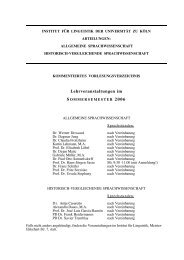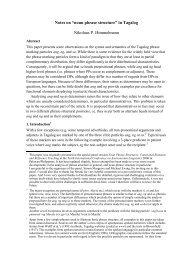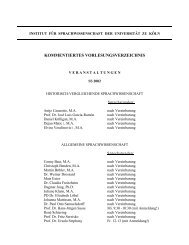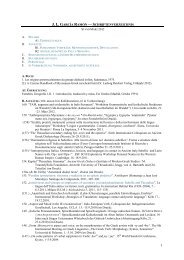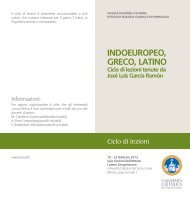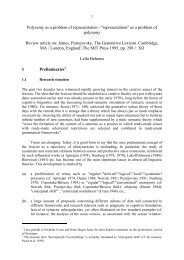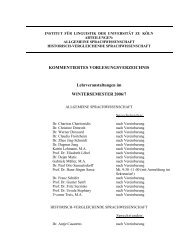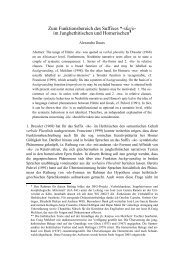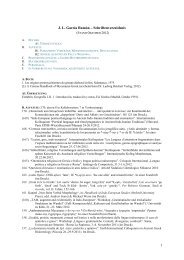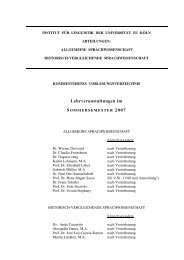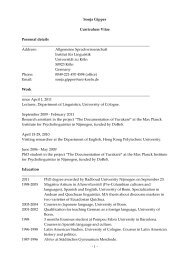Topics in Anatolian Historical Grammar Prof. Dr. H. Craig Melchert
Topics in Anatolian Historical Grammar Prof. Dr. H. Craig Melchert
Topics in Anatolian Historical Grammar Prof. Dr. H. Craig Melchert
Create successful ePaper yourself
Turn your PDF publications into a flip-book with our unique Google optimized e-Paper software.
13<br />
We may thus assume that the prehistoric paradigm of ‘die’ was *nākki, akkanzi. It is hardly<br />
surpris<strong>in</strong>g that this very irregular allomorphy was elim<strong>in</strong>ated, and as <strong>in</strong> the case of wāki, *ūganzi<br />
‘bite(s)’ and *ištāmpi, ištappanzi ‘stop(s) up’, the “repair” chosen was assimilation to the class of<br />
nāḫi, naḫḫanzi. Depend<strong>in</strong>g on the relative chronology of the changes, it is possible that wāki,<br />
wakkanzi served as the model for aki, akkanzi or vice-versa.<br />
In sum, due to a “Brugmann” effect that “lenited” *h 2 after accented short *ó, the pattern<br />
Pres3Sg <strong>in</strong> -āC 1 i vs. Pres3Pl <strong>in</strong> -aC 1 C 1 anzi developed regularly <strong>in</strong> the case of naḫḫ- ‘to affright;<br />
fear’ and *šaḫḫ- ‘to fill up’. It was analogically extended to ḫi-verbs <strong>in</strong> -ašš-: ḫašš- ‘to beget;<br />
give birth’, ḫašš- ‘to open’, and pašš- ‘to swallow’ (also to zaḫḫ- ‘to strike’ if it was not regular<br />
there). F<strong>in</strong>ally, it also spread to verbs with f<strong>in</strong>al stop which for various reasons had developed<br />
very irregular allomorphy: wāgi, *ūganzi ‘bite(s)’, *ištāmpi, ištappanzi ‘stop(s) up’, and *nākki,<br />
akkanzi ‘die(s)’. 16<br />
References<br />
Adiego Lajara, Ignacio-Javier. 2001. Lenición y acento en protoanatolico. In Onofrio Carruba<br />
and Wolfgang Meid (eds.), Anatolisch und Indogermanisch. Anatolico e <strong>in</strong>doeuropeo. Akten<br />
<strong>Melchert</strong> 1994a: 125). As per above (with note 2), the two adverbs katta cannot be derived from<br />
unaccented forms (contra Kloekhorst 2008: 464).<br />
16 The contrast of šāku(wa)- ‘eye’ < *sók w o- (<strong>Melchert</strong> 1994a: 61, Kloekhorst 2008: 704) or<br />
more likely *sh 3 ók w - (cf. Rieken 1999: 59-60 with refs.) with nekku ‘nonne’ suggests that<br />
“lenition” after short *ó may also have affected the voiceless labiovelar *k w , <strong>in</strong> contradist<strong>in</strong>ction<br />
to the other voiceless stops. However, to affirm this claim a full review of all the evidence is<br />
required, which cannot be undertaken here.



